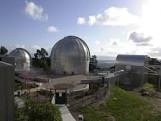Many of the world’s leading cosmologists suspect that most of the universe consists of matter and energy about which we know next to nothing. One of our own Chabot Space and Science Center volunteers, Leonard Traumel, outlined how and why scientists posit the existence of as-yet undetectable ‘dark’ matter and energy.
Traumel began his talk by pointing out how we can’t always rely on our intuition or even our empirical observation to understand the universe. Evolution prepared us to find food and avoid capture on the savannas of Africa, and so our brains developed the ability to grasp and predict the functioning of matter within the space and time scales where we lived. There’s no guarantee that our gray matter will automatically process how things work at a level very far removed from human experience.
So, scientists use tools such as mathematical modeling and the scientific method to conceptualize and iteratively refine our understanding of the world. One of the major forces we’ve been able to model is gravity, where the attractive force between two objects can be expressed as a constant multiplied by the product of their masses and divided by the square of the distance between them. We can estimate, then, how much gravitational force the visible matter we see around us in the universe would experience and how much that would tie the universe together.
We can also model red shifts, where the wavelength of light, and thus the color, coming from an object changes depending on whether it’s moving towards or away from us. We also notice, and expect from the Big Bang, that the universe will be homogeneous and isotropic, with matter evenly distributed and symmetrical in all directions. So, in a manner of speaking, we are at the center of the universe, and the same could be said of everywhere else. Astronomers observe a red shift effect when we look outward at objects beyond Earth. If we see a red shift, indicating that matter is moving away from us, and the universe is homogeneous, we conclude that the universe is expanding. However, nothing we know of yet tells us how much matter should be in the universe or how quickly our world should be expanding.
Our observations do suggest the validity of the Big Bang as a model for the universe’s development. We observe background microwave radiation throughout the universe, as we would expect to have been produced in the early days as the world cooled. We also see expansion occurring at a rate linearly proportional to the distance between objects, as we would expect from mathematical models of the Big Bang, and hydrogen, helium and lithium occur in the abundances expected given the time that matter has had to cool and clump together.
However, according to our current models, gravitational force isn’t strong enough to hold the amount of observed matter in the universe together at all at the speed it’s moving away from itself. So, we think there must be some sort of matter we don’t see and can’t directly observe, which researchers tentatively call ‘dark’ matter.
We can use gravitational lensing, observations of how much gravity bends rays of light, to determine the mass of objects in the universe. And we do know that there are large clouds of interstellar gas, but not whether those clouds alone can account for all of the extra mass that we need to explain the observed workings of gravity. Hence, cosmologists’ theory of extremely dense dark matter existing somewhere in the universe.
Scientists can measure distances within the universe with the help of standard candles, stars which brightness is proportional to the time they have been burning. There are also type 1A supernovae which are larger and brighter and serve a similar function. Each galaxy has about one of these every 400 years, so we see one through our telescopes somewhere in the universe about once a week.
Given the long-term effects of gravity, we would expect there to be a deceleration to the universe’s expansion, for it to gradually be slowing down. However, we’re observing the expansion accelerating. Cosmologists have no idea why this is happening, so have posited the existence of dark energy, which does not interact with light. As with dark matter, we see the effects of dark energy but cannot directly observe it.
According to current models, the visible matter we see only makes up about five percent of the universe. Dark matter comprises 25 percent and the remaining 75 percent is dark energy.
This may seem like an awful lot of conjecture to accept, but Leonard Traumiel again reminded us to look beyond the intuition and senses we have evolved over time and trust the mathematics we have also developed as a source of information about the universe.


Though I do not have a background in cosmology other than what we were taught in school, still I find this piece very fascinating. This subject is something I never would have thought about. So, I am receiving a small education about our galaxy and the evidence of dark matter. We take for granted the world around us and most of us never think of how busy it is expanding and creating dark matter in our universe. I will be re-reading this many more times.